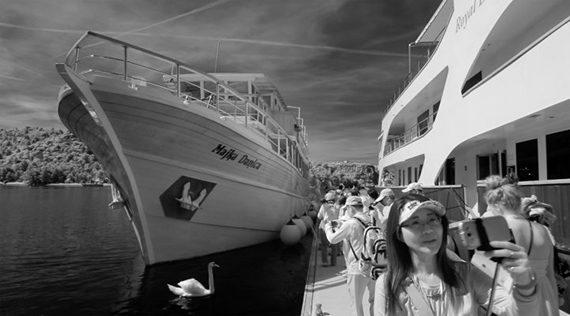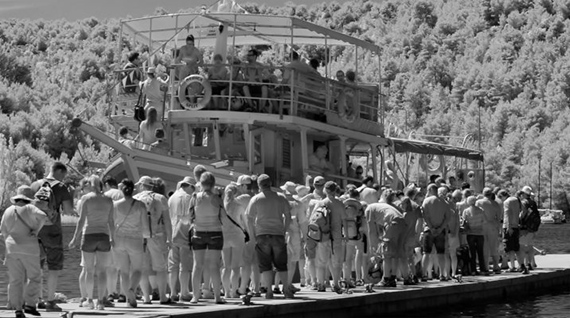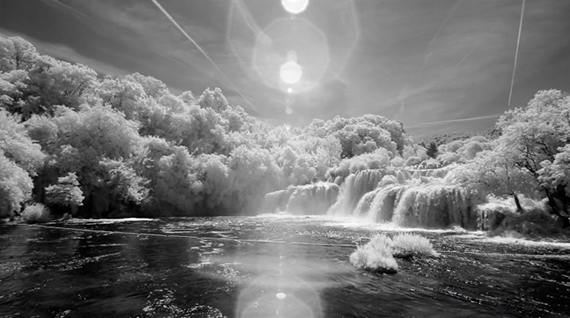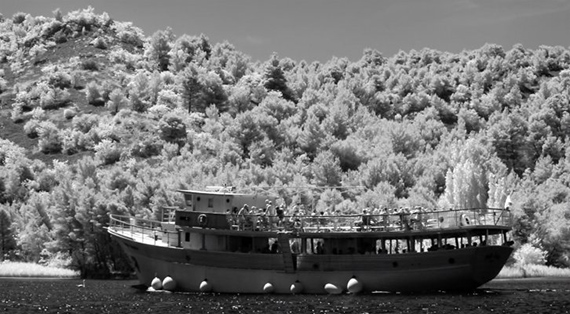
Mali Arun »
Paradisus
Exhibition: 3 Jul – 13 Sep 2020

Foam Fotografiemuseum Amsterdam
Keizersgracht 609
1017 DS Amsterdam
+31 (0)20-5516500
pressoffice@foam.org
www.foam.org
Mon-Wed 10-18; Thu-Fri 10-21; Sat-Sun 10-18

In front of the camera a breathtaking landscape in black and white unfolds, teeming with lush vegetation and overwhelming waterfalls. In search of a kind of 'primal image' of earthly Paradise, photographer and filmmaker Mali Arun (1987, France) travelled to the seemingly untouched Krka nature reserve in Croatia. What she found there turned out to be far from paradise. The place is overrun by a never-ending stream of tourists who move in large numbers through the landscape, albeit uncomfortably. Static, without tricks or elaborate artistic interventions, the camera simply registers the discomfort and the detachment with which modern man relates to his once natural habitat. We see tourists 'consume' the landscape en masse, as if it were an amusement park. As the film progresses, it takes on a steadily more oppressive undertone. The overwhelming natural beauty gradually turns into the setting for what increasingly resembles an apocalyptic doom scenario.

Through an endless number of selfie sticks, iPads, iPhones and cameras, the Creation is infinitely shared and multiplied. Paradise, which is considered unknowable and whose depiction was forbidden in certain times and cultures, becomes reproducible and indiscriminately accessible to everyone. Instead of heaven, Arun's version of Paradise seems to herald the end of time, as a contemporary variant of Hieronymus Bosch's Garden of Earthly Delights (1482). With the difference that this unreal situation was not imagined by the artist, but is a direct documentation of reality. Yet even reality appears surreal in the work of Arun. The only modulation in Paradisus is the use of an infrared UV filter that solarises the image (a process that partially reverses light and dark tones through over-exposure), giving the image an eerie and futuristic quality.
Blending fact and fiction, Arun’s work hovers between documentary-making and storytelling. At no point in the film do we learn where the footage is shot, and it seems irrelevant: the landscape becomes a metaphor for the expulsion of man from the Garden of Eden, as described in the Old Testament. Quotations from Genesis serve as subtitles of what the artist describes as 'the first, and possibly also the last image' of earthly Paradise.
The artistic practice of Mali Arun (1987, FR) mostly focuses on video work and photography plays a prominent role. Her work concentrates on how humans navigate the man-made landscape, particularly within and between borders. Arun studied at the École Nationale Supérieure des Arts Visuels in Brussels, at the Beaux-Arts in Paris and in Tianjin, China. Her films have been screened at several film festivals including Clermont-Ferrand, Cabourg, St. Petersburg, Pantin, Cinémathèque Française, Festival Tous Courts d'Aix-en Provence, where she won the jury award, and at Visions du Réel in Nyon where she won the Grand Price of the Burning Lights competition. Her work has been aired by Arte and Le Radi. Arun lives and works in Strasbourg and Paris.
The exhibition is made possible by the Van Bijlevelt Foundation.
